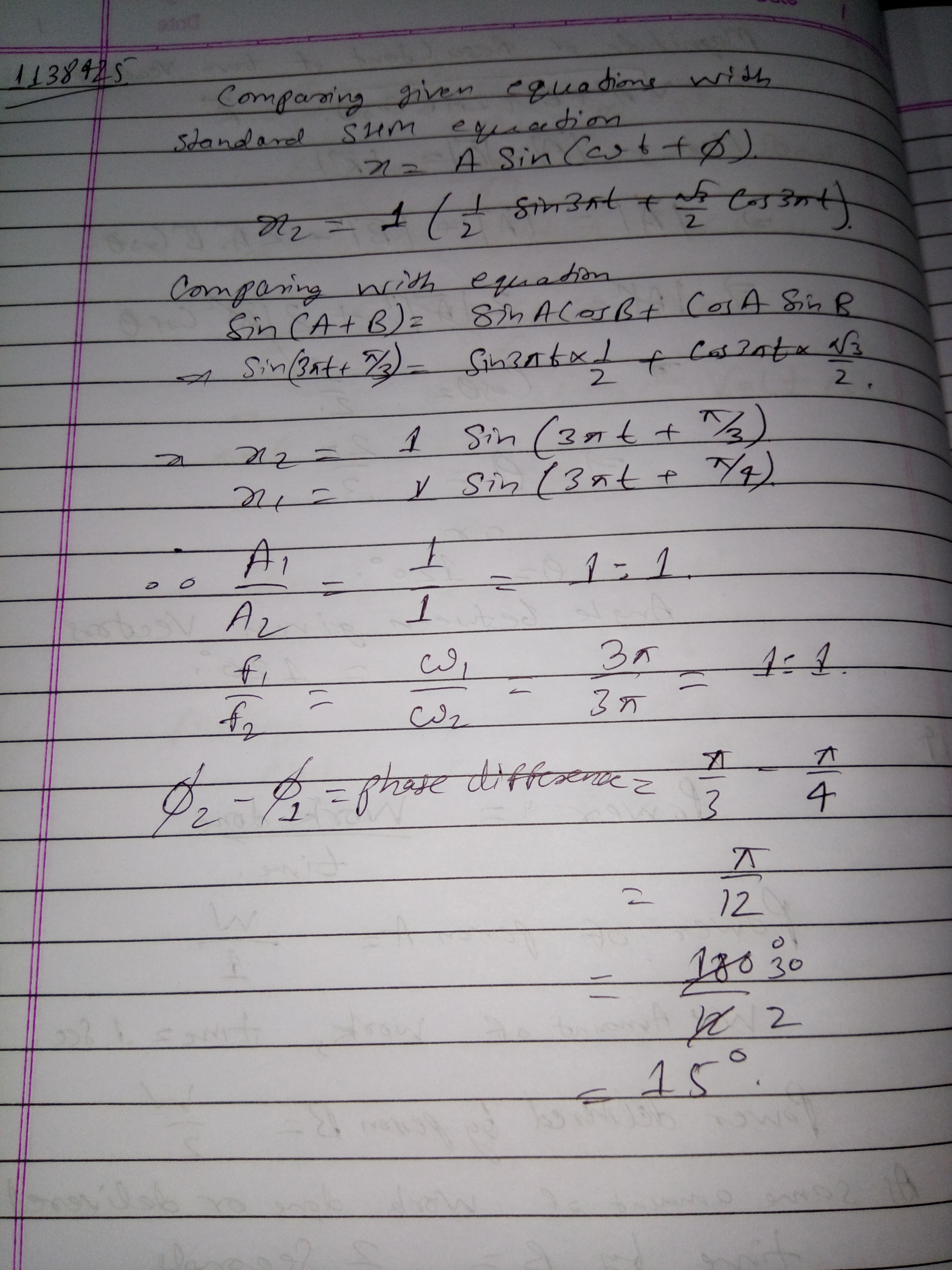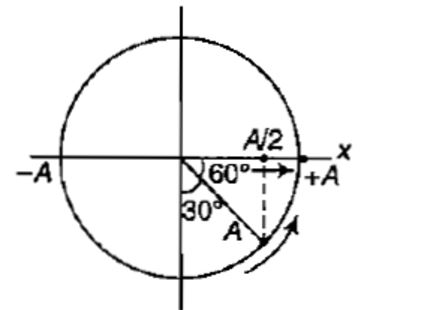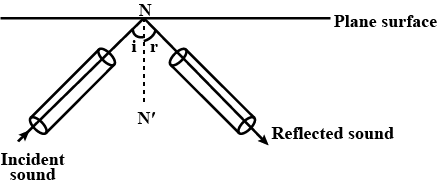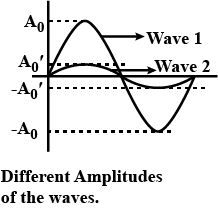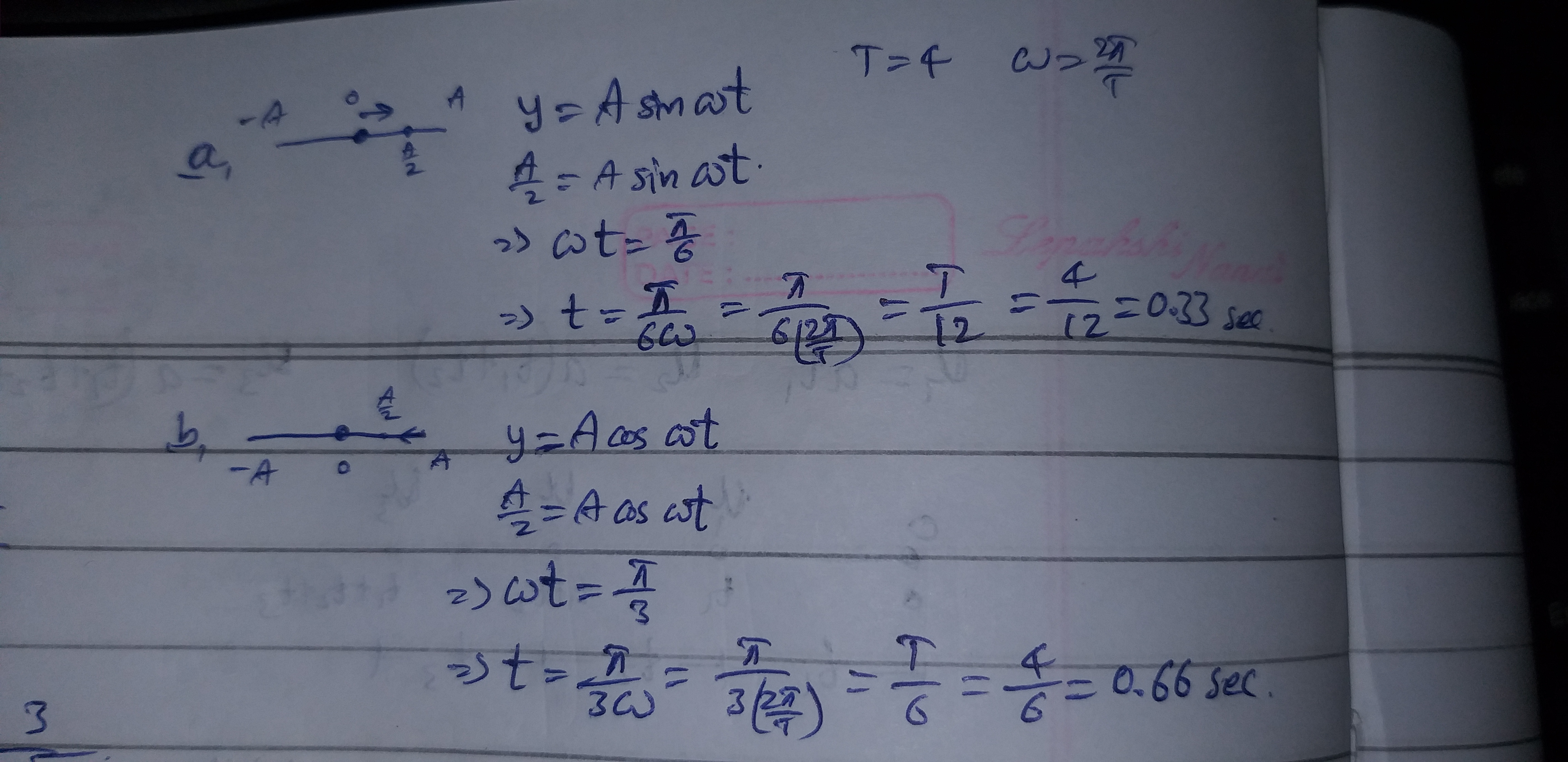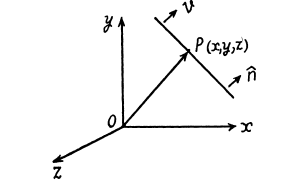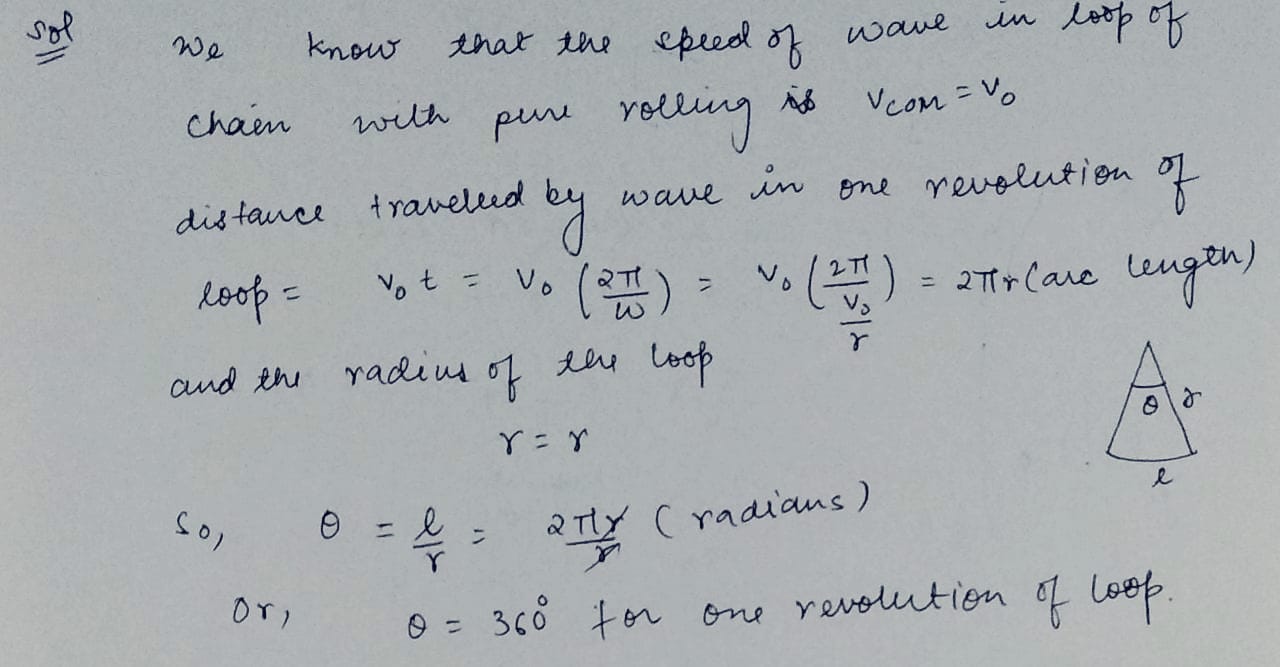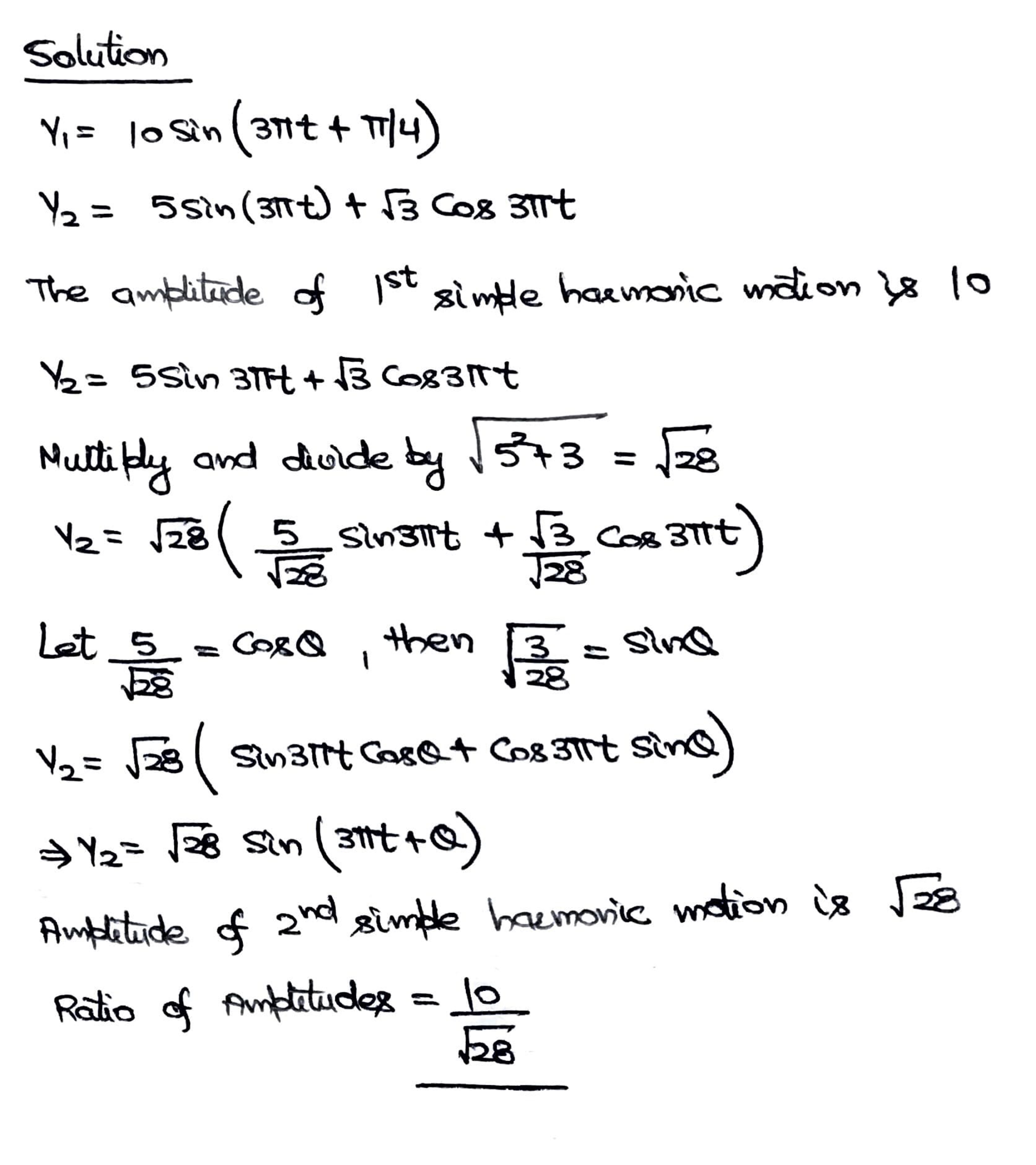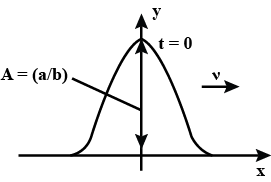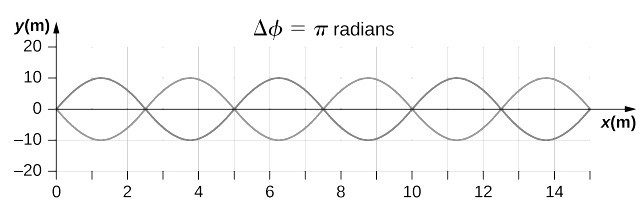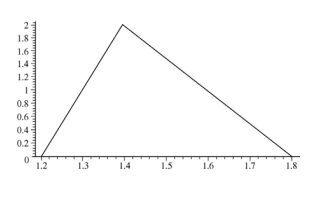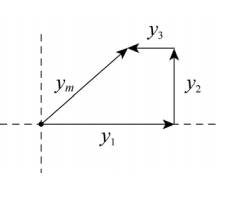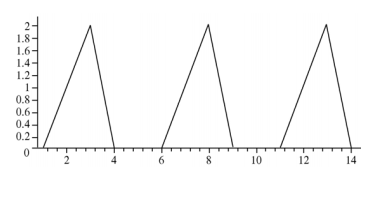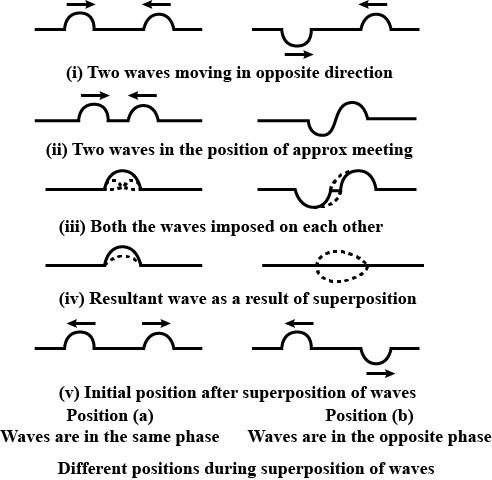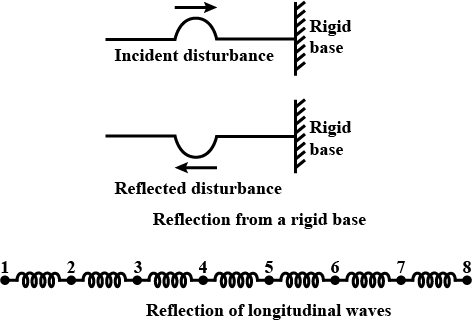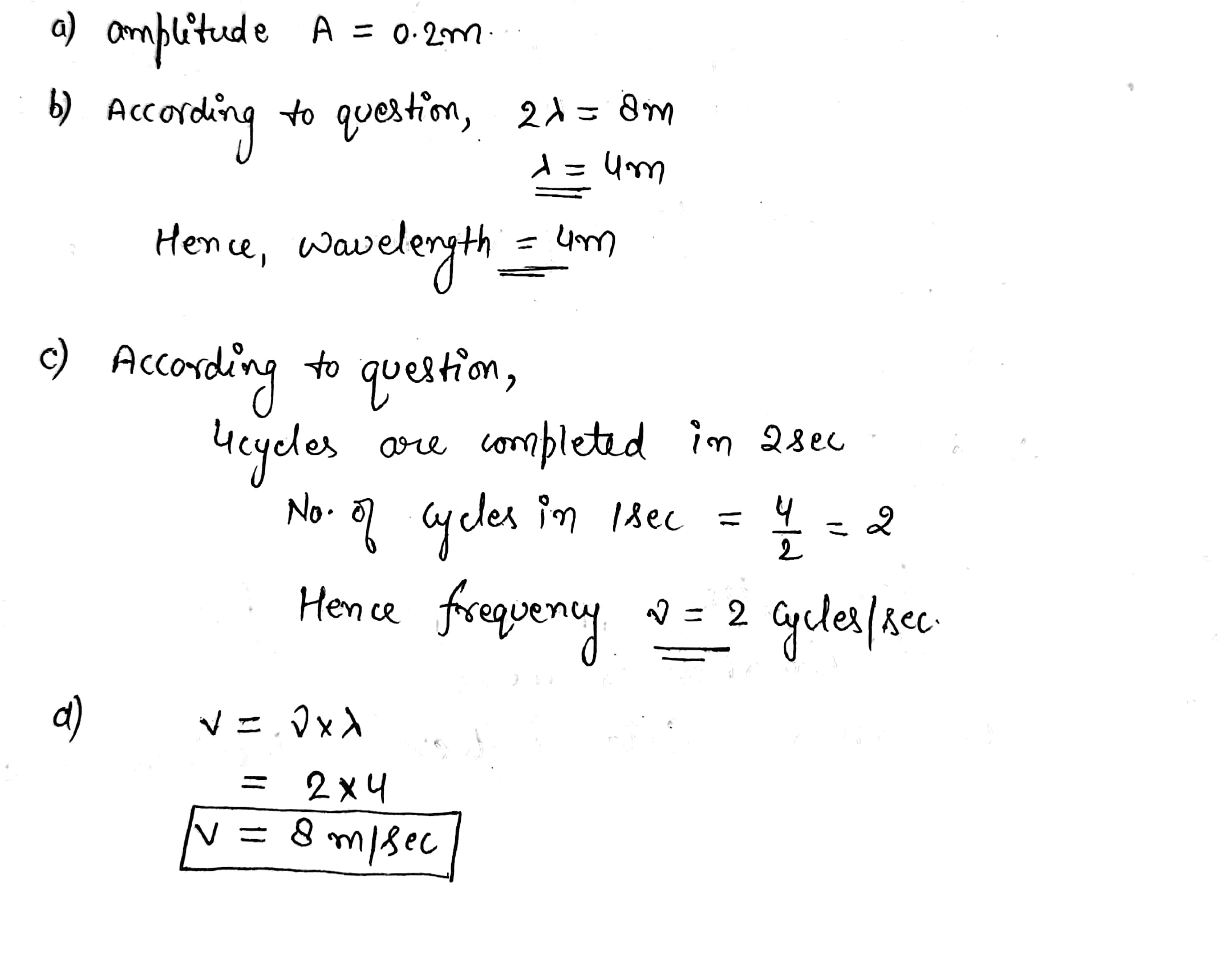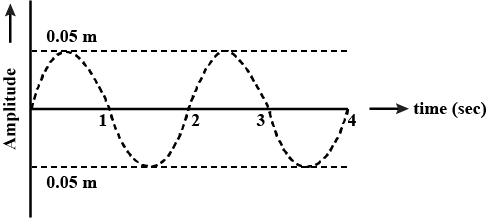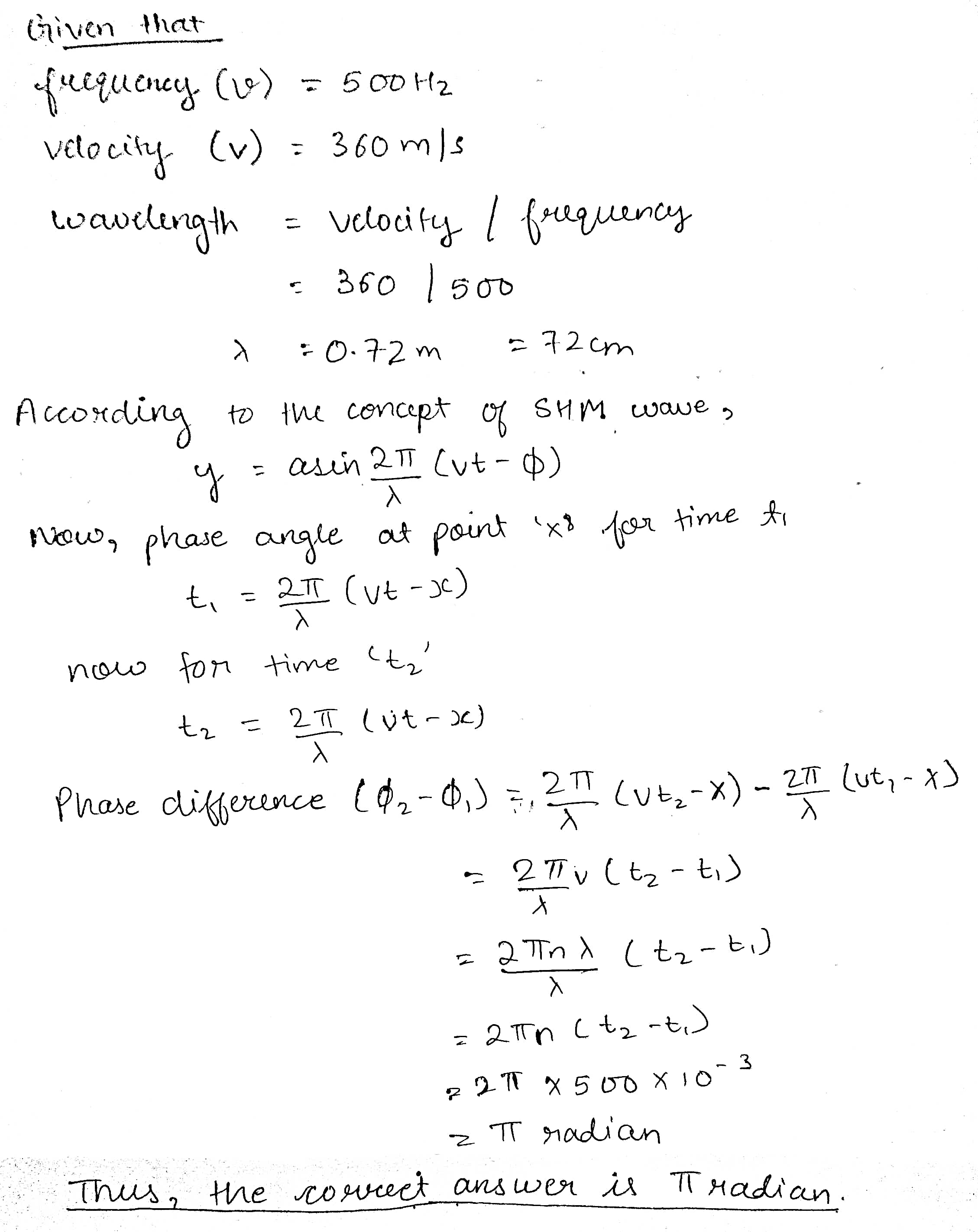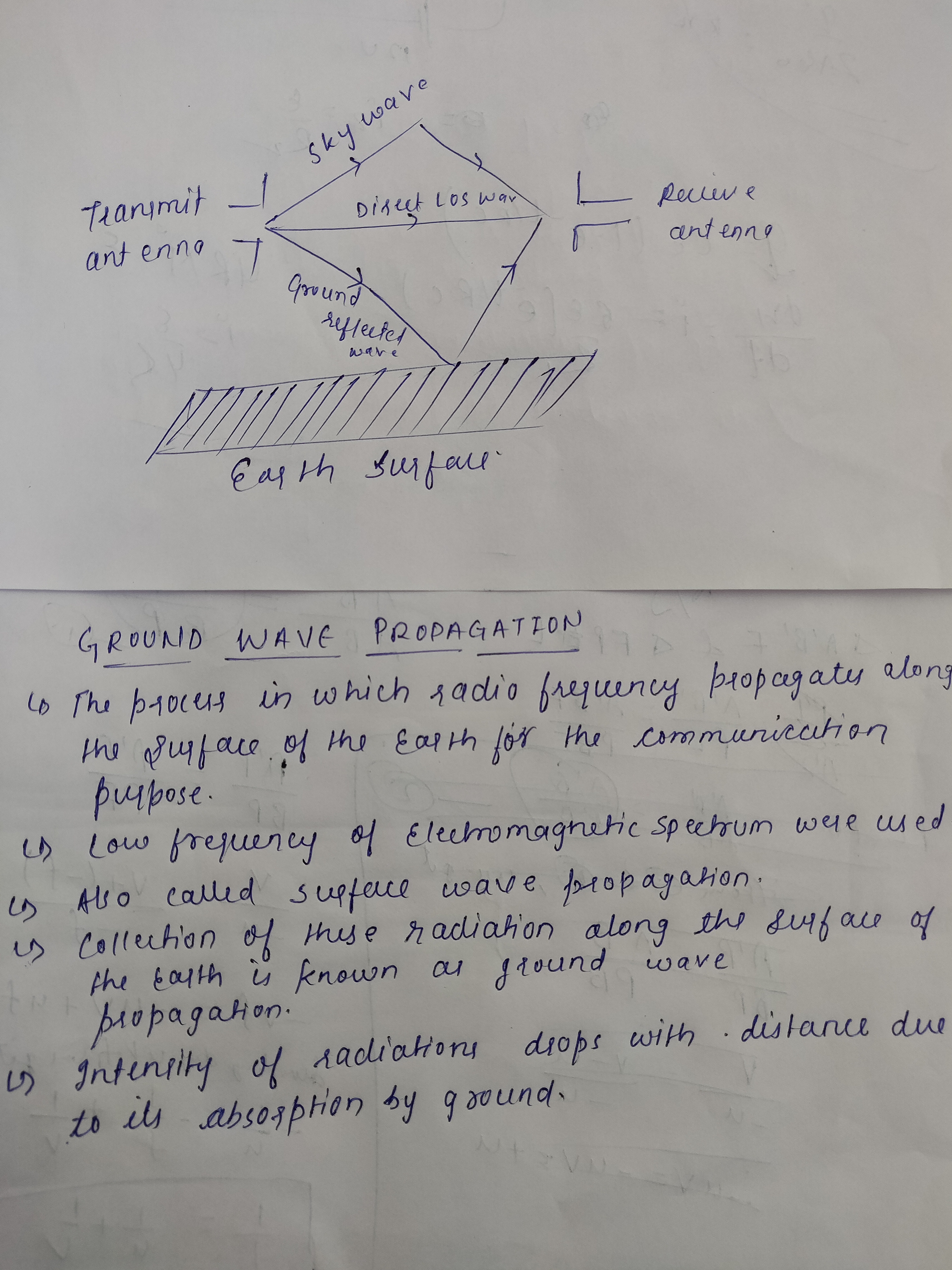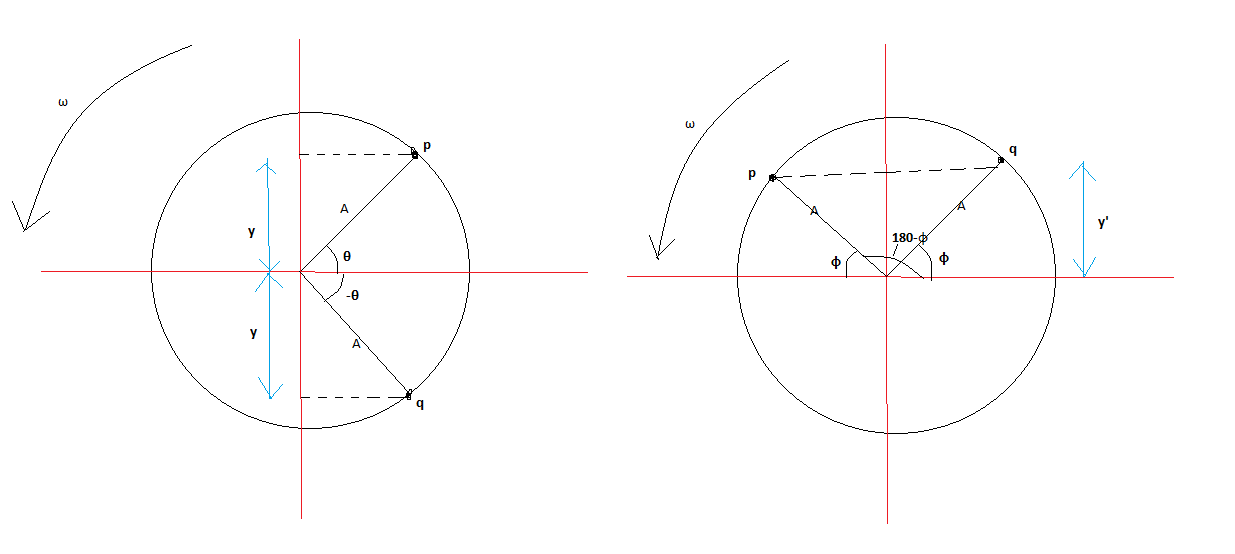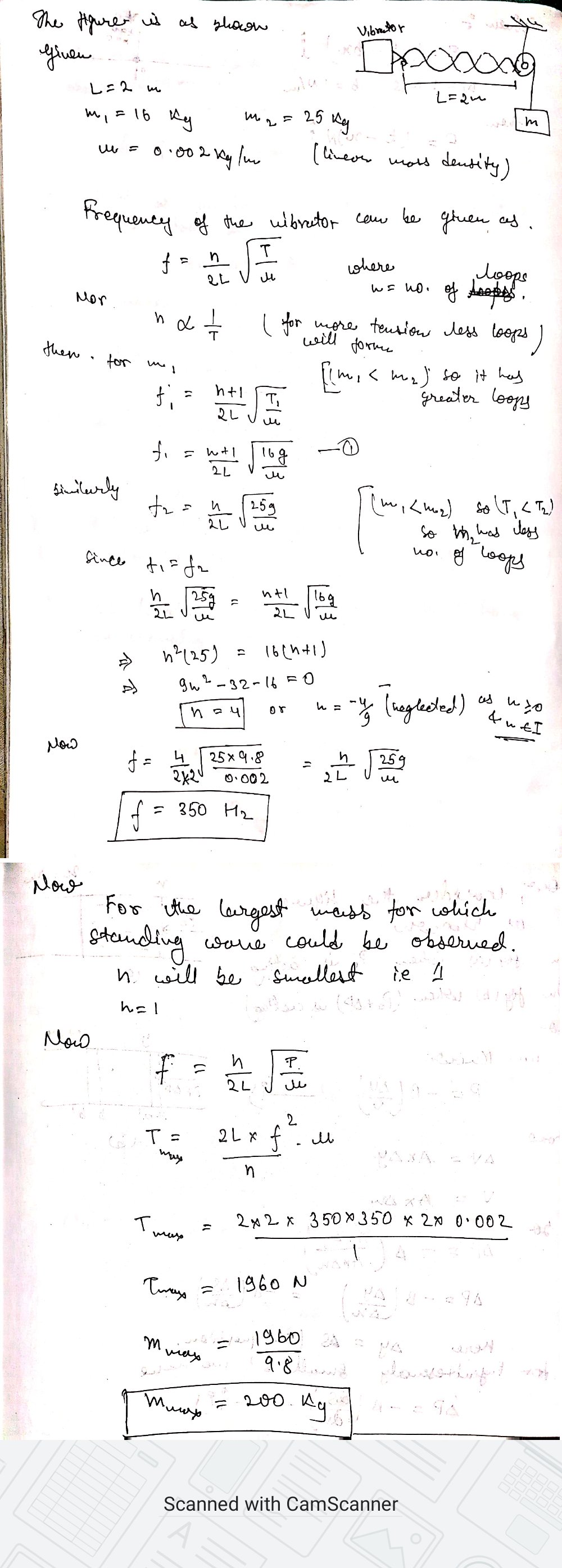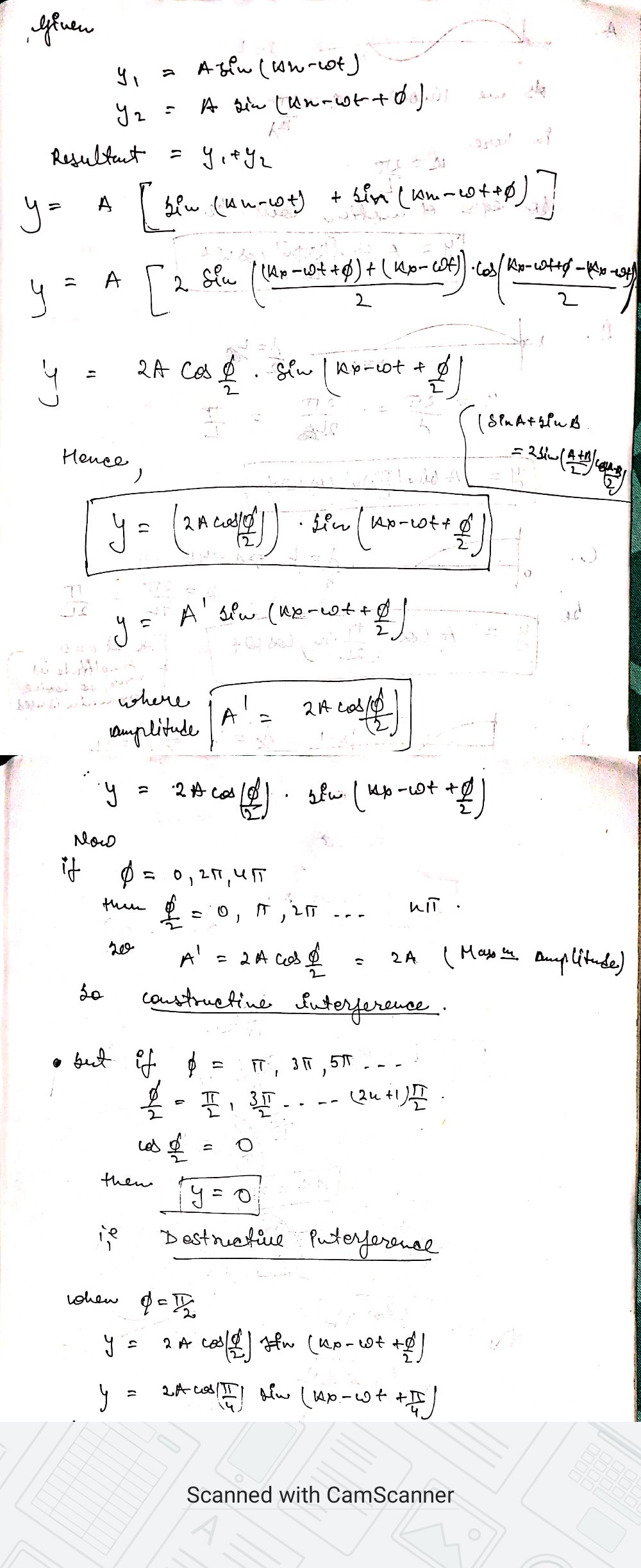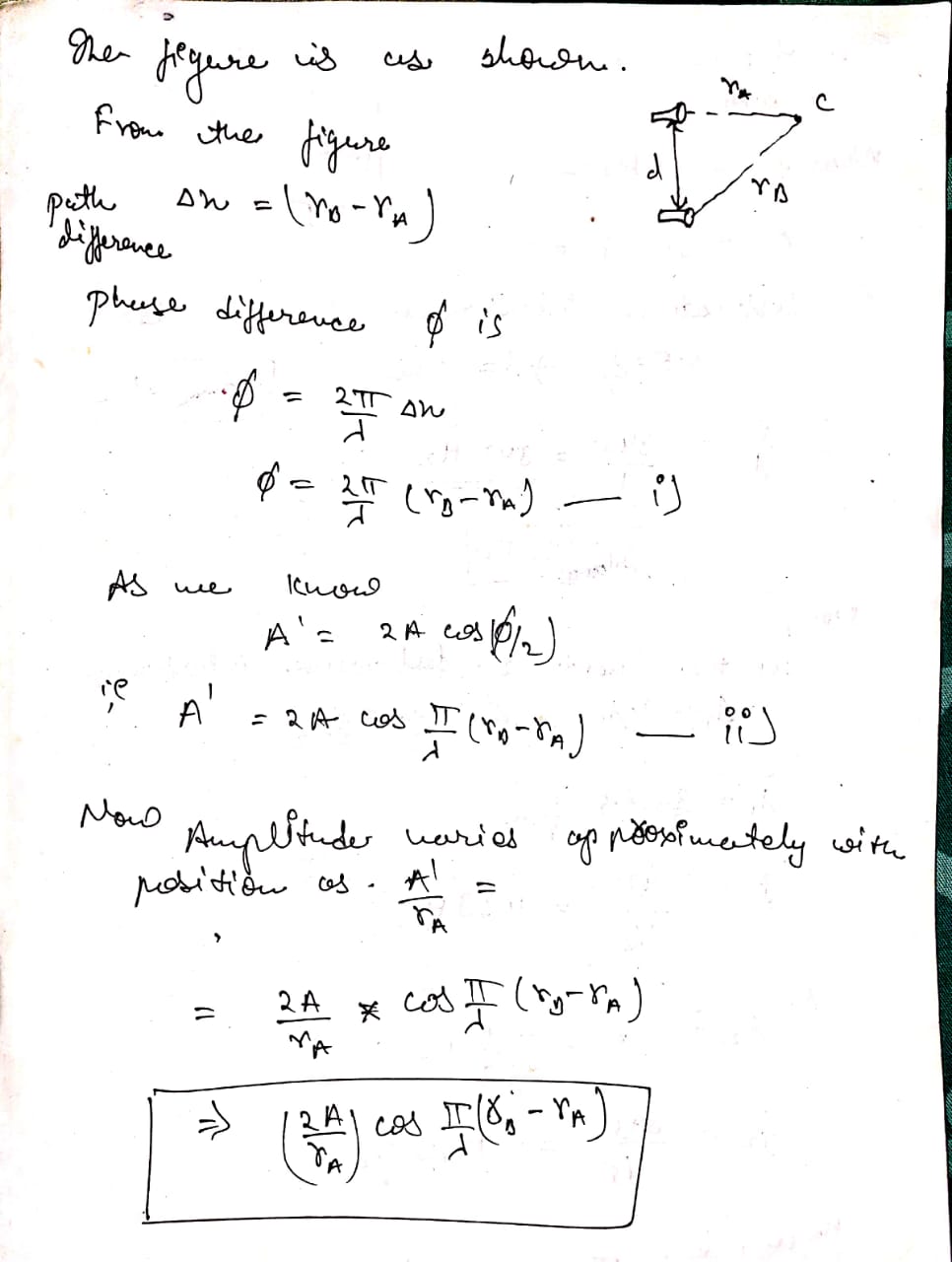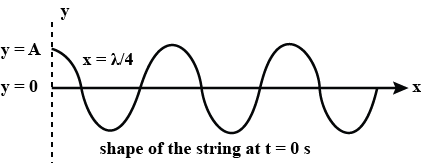Waves - Class 11 Engineering Physics - Extra Questions
Find the velocity of a wave whose frequency is 60 Hz and wavelength is 20 m.
The amplitude (in mm)

A wave yi=0.3cos(2.0x−40t) is travelling along a string toward a boundary at x =Write expressions for the reflected waves if the string has a fixed end at x = 0.
A wave has a low speed but a high frequency. What can you infer about its wavelength?
When a sound is reflected from a distinct object, an echo is produced. Let the distance between the reflecting surface and the source of sound production remains the same. Do you hear echo sound on a hotter day?
List two applications of reflection of sound.
A radar sends a signal to an aircraft at a distance of 30 km away and receives it back after 2×10−4 second. What is the speed of the signal?
Two SHM's are
x1(mm,=sec)=1.0sin[π4(12t+1)] and x2(mm,=sec)=0.5[sin3πt+√3cos3πt]
Discuss the ratio of their amplitudes, frequency and find the phase difference.
A particle oscillates in a plane as per the relation x=4(cos(πt)+sin(πt)). Find amplitude of oscillations.
Calculate the amplitude of the S.H.M. represented
by x=5√2(sin2πt+cos2πt)m
When a wave is propagating from a rarer to a denser medium, which characteristic of the wave does not change and why ?
What is wave?
Answer the following :
Name the wave/waves produced in a long slinky.
Define amplitude.
Define the following terms.
Wave amplitude
Explain following terms
Wave
What will be the resultant amplitude when 2 waves y1=asinωt are superposed at any point at a particular instant?
What is meant by a wave?
There is a mistake in each of the following ray diagrams given as Fig. 16.9 a, b, and c. Make the necessary correction (s).

Match the following
A travelling wave pulse is given by. y\, =\, \displaystyle \frac{10}{5\, +\, (x\, +\, 2t)^{2}} Here, x and y are in metre and t in second. In which direction and with what velocity is the pulse propagating ? What is the amplitude of pulse?
A wave of frequency 500 Hz has a wave velocity of 350 m/s. The distance between two points which point are 60^0 out of phase is 116 \times 10^{-x} m . Find x.
A wave is represented by y_1\, =\, 10 cos (5x\, +\, 25 t)
where, x is measured in metres and t in seconds. A second wave for which \displaystyle y_2\, =\, 20 cos\, \left ( 5x\, +\, 25t\, +\, \frac{\pi}{3} \right )
interferes with the first wave. Deduce the amplitude and phase of the resultant wave.
x = 1.50 cm
x = 0.500 cm
Two sinusoidal waves combining in a medium are described by the equations
y_1\, =\, (3.0 cm)\, sin\, \pi (x\, +\, 0.60t)\, \quad\, and\, \quad\, y_2\, =\, (3.0 cm)\, sin\, \pi (x\, -\, 0.60t)
where, x is in centimetres and t is in seconds. The maximum displacement of the medium at x = 0.250 cm is 4.24 \times 10^{-x} m. Find x.
A string of length 20\ cm and linear mass density 0.4\ g/cm is fixed at both ends and is kept under a tension of 16 \ N. A wave pulse is produced at t = 0 near an end as shown in the figure which travels towards the other end. Sketch the shape of the string at a time half of its time period.
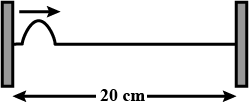
A certain transverse wave is described by
\displaystyle\,y\,(x,\,t)\,=\,(6.50\,mm)\,cos\,2\,\pi\,\left ( \frac{x}{28.0\,cm}\,-\,\frac{t}{0.0360\,s} \right )
The wave's amplitude is 6.50 \times 10^{-x} m. Find the value of x.
A particle executes simple harmonic motion of amplitude A along the x-axis. At t =0, the position of the particle is x =\dfrac{A}{2} and it moves along the positive x-direction. Find the phase constant \delta , if the equation is written as x=A\sin \left ( \omega t+\delta \right ) :
A wave of frequency 500 Hz has a wave velocity of 350 m/s. Find the phase difference in degrees between two displacements at a certain point at times 10^{-3} s apart.
Two waves of same amplitude and same intensity interfere at one point. Phase difference between them is \theta. Match the following two columns.
Name two wave interaction that can occur when a wave encounters a barrier.
Explain why you can hear two people talking even when they walk around a corner.
If the wavelength of a sound source is reduced by a factor of 2, what happens to the waves frequency? What happens to its speed?
You have learnt that a travelling wave in one dimension is represented by a function y = f (x,t) where x and t must appear in the combination x - v t or x + v t i.e. \displaystyle y = f(x\pm v t). Is the converse true ? Examine if the following functions for y can possibly represent a travelling wave :
(a) \displaystyle (x+vt)^{2}
(b) \displaystyle \log \left [ \left ( x+vt \right )/x_{o} \right ]
(c) 1/(x+vt)
A hospital uses an ultrasonic scanner to locate tumours in a tissue. What is the wavelength of sound in the tissue in which the speed of sound is 1.7 km \displaystyle s^{-1} ? The operating frequency of the scanner is 4.2 MHz.
Does sound follow the same laws of reflection as light does? Explain.
The minimum distance between two particles in same phase is 18 cm. If the velocity of the wave is 36 m {s}^{-1}, then find the time interval after which the given particle undergoes a phase change of \pi.
Find the phase difference between a particle at {1}^{st} crest and a particle at {4}^{th} crest.
Ultrasonic sound of frequency 100 kHz emitted by a bat is incident on a water surface. Calculate the wavelength of reflected sound and transmitted sound? (speed of sound in air 340 m {s}^{-1})
Given that sound travels in air at 340 {m}/{s}, find the wavelength of the waves in air produced by a 20 kHz sound source. If the same source is put in a water tank, what would be the wavelength of the sound waves in water? Speed of sound in water = 1,480 {m}/{s}.
A sound wave travels at a speed of 340 {m}/{s}. If its wavelength is 2 cm, what is the frequency of the wave? Will it be in the audible range?
Deduce the relation between wavelength, frequency and speed of sound.
A sound wave whose frequency is 220 Hz has a speed of 440 ms^{-1} in a given medium. Find the wavelength of the sound.
A transverse wave of amplitude 0.01\ m and frequency 500\ Hz is travelling along a stretched string with a speed of 200 m/s. Find the displacement of a particle at a distance of 0.7\ m from the origin after 0.01s. Also find the phase difference between the point where wave reaches from the origin
Find odd man out:
Give reason for your answer.
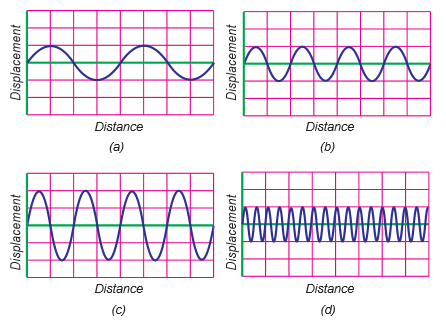
Derive the relation between the velocity of wave, wavelength and frequency.
A certain sound has a frequency of 256 hertz and a wavelength of 1.3m. Calculate the speed with which this sound travels.
In what time after its motion begins, will a particle oscillating according to the equation x = 5 cos 0.2 \pi t move from the mean position to maximum displacement position?
Equations of a stationary wave and a travelling wave are y_{1} = a\sin kx \cos \omega t and y_{2} = a\sin (\omega t - kx). The phase difference between two points x_{1} = \dfrac {\pi}{3k} and x_{2} = \dfrac {3\pi}{2k} is \phi for the first wave and \phi_{2} for the second wave. Find the ratio \dfrac {\phi_{1}}{\phi_{2}}.
The equation of a simple harmonic wave is given by y=6\sin { 2\pi \left( 2t-0.1x \right) } , where 'x' and 'y' are in mm and 't' is in seconds. Find the phase difference between two particles 2mm apart at any instant.
A certain sound has a frequency of 256 hertz and a wavelength of 1.3m. What difference would be felt by a listener between the above sound and another sound travelling at the same speed, but of wavelength 2.6m?
An object of mass 0.2kg executes SHM along the x-axis with frequency of (25/ \pi) Hz. At the point x=0.04m the object has KE 0.5J and PE 4J. The amplitude of oscillation is ________ .
The displacement of particle performing S.H.M. is given by
\displaystyle x = \left[ 5 sin \pi t + 12 sin \left( \pi t + \frac{\pi}{2} \right) \right] cm. Determine the amplitude, period and initial phase of the motion.
A wave train has the equation y=4\sin (30\pi t+0.1x) where x is in cm and t in seconds. What is the frequency of the source? How much time does a wave pulse take to reach a point 30 cm from it?
Two SHMs are represented by y_{1} = A sin (\omegat + \phi), y_{2} = A/2 [sin \omega t + \sqrt{3} cos \omegat]. Find ratio of their amplitudes.
The equation of a wave propagating along a stretched string is given by Y=4\sin 2\pi [(t/0.02)-(x/100)], where Y and x are in cm and t in second. Determine the amplitude.
Two sinusoidal waves of the same frequency travel in the same direction along a string. If A_{1}=3.0\ cm, A_{2}=4.0\ cm, \phi_{1}=0, and \phi_{2}=\pi/2\ rad, what is the amplitude of the resultant wave?
A string oscillates according to the equation y'=(0.50cm)\sin\left[\left(\dfrac{\pi}{3}cm^{-1}\right)x\right]\cos[(40\pi s^{-1})t]. What is the speed of the two waves(identical except for direction of travel) whose superposition gives this oscillation?
The motion of a particle executing simple harmonic motion is described by the displacement function x\left( t \right)= A\cos { \left( wt+\phi \right) } . If the initial ( t= 0) position of the particle is 1 cm and its initial velocity is w cm/s, what are its amplitude and initial phase angle? The angular frequency of the particle is \pi { s }^{ -1 }. If instead of the cosine function , we choose the sine function to describe the SHM x=B\sin { (wt+\alpha ) } , what are the amplitude and initial phase of particle with the above initial conditions?
Two identical travelling waves, moving in the same direction, are out of phase by \pi/2\ rad. What is the amplitude of the resultant wave in terms of the common amplitude y_{m} of the two waves.
If we put a cardboard (say 20 cm x 20 cm) between a light source and our eyes, we can't see the light. But when we put the same cardboard between a sound source and our ear, we hear the sound almost clearly. Explain.
A wave has the equation y = 0.1 \sin [ 100 \pi t- kx] and wave velocity 100 m/s , its wave number is equal to
A particle executing simple harmonic motion completes 1200\ oscillations\ per\ minute and passes through the mean position with a velocity of 3.14\ ms^{-1}. Determine the maximum displacement of the particle from its mean position . Also obtain the displacement equation of the particle if it particle if its displacement be zero at the instant t = 0.
Draw the figures depicting low amplitude and high amplitude?
What do you understand by the term wave?
A particle is executing S.H.M. of time period 4s. What is the time taken by it to move from the
a) Mean position to half of the amplitude.
b) extreme position to half of the amplitude.
Explain the reflection of sound waves from curved surface.
A car is moving towards a hill cliff. The driver sounds a horn of frequency f. The reflected sound heard by the driver has frequency 2f if v the velocity of sound, then the velocity of the car , in units will be.
A wave of amplitude 10 cm and frequency 1000 Hz is travelling with a velocity of 300 m/s. Calculate the phase difference of a particle at a distance of 3 m from the origin after 1.001 s
If the maximum speed of a particle in a traveling wave is v_{0}, then find the speed of a particle when the displacement is half of the maximum value.
The displacement at a point due to two waves are y_{1}=sin(500\pi t)and y_{2} =2sin(506\pi t). The result due to their superposition will be
Two wires of the same material and having the same radius have their fundamental frequencies in the ratio 1:2 and under tension in the ratio 1:8, Compare ratio of their lengths.
What is an amplitude?
How are the wave velocity V , frequency f and wavelength \lambda of a wave related ? Derive therelationship.
A nylon guitar string has a linear density of 7.20 g/m and is under a tension of 150 N. The fixed supports are distance D = 90.0 cm apart. The string is oscillating in the standing wave pattern shown in figure. Calculate the (a) speed. (b) wavelength, and (c) frequency of the travelling waves whose superposition gives this standing wave.
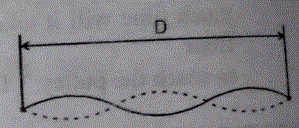
i) From differential equation of linear S.H.M., obtain an expression fro acceleration, velocity and displacement of a particle performing S.H.M.
ii) A sonometer wire 1 metre long weighing 2 \,g in is resonance with a turning fork of frequency 300 \,Hz. Find tension in the sonometer wire.
State any four characteristics of a simple harmonic progressive wave.
A plane harmonic wave with frequency \omega propagation at a velocity v in a direction forming angles \alpha, \beta, \gamma with the x, y, z axes. Find the phase difference between the oscillation at the points of medium with coordinates x_1, y_1, z_1 and x_2, y_2, z_2.
By reference to two waves, state:
(i) the principle of superposition.
(ii) what is meant by coherence.
Two coherent waves P and Q meet at a point in phase and superpose. Wave P has an amplitude of 1.5\ cm and intensity I. The resultant intensity at the point where the waves meet is 3I.
Calculate the amplitude of wave Q.
amplitude = _______ cm.
A wave pulse is travelling on a string with a speed v towards the positive X-axis. The shape of the string at t = 0 is given by g(x) = A \sin (x /a) , where A and a are constants.
What are the dimensions of A and a?
A bug on the surface of a pond is observed to move up and down a total vertical distance of 1.0\ m, lowest to highest point, as a wave passes.
What is the amplitude of the wave?
The equation of a wave travelling on a string stretched along the X-axis is given by
y = Ae^{\left(\dfrac{x}{a} + \dfrac{t}{T} \right)^2}
Write the dimension of A, a and T.
If loop of chain is spun at high speed, it will roll like a hoop without collapsing. Consider a chain of linear mass density \mu that is rolling without slipping at a high speed v_0.
How far around the loop ( in degrees) will a transverse wave pulse travel in the time the hoop rolls through one complete revolution ?
Two waves, travelling in the same direction through the same region, have equal frequencies, wavelengths and amplitudes. If the amplitude of each wave is 4mm and the phase difference between the waves is 90^{\circ}, what is the resultant amplitude?
Two sinusoidal sound waves with frequencies 108\ Hz and 112\ Hz at your ear simultaneously. Each wave has an amplitude of 1.5\times 10^{-8}m when it reaches your ear.
What is the maximum amplitude of the total sound wave? What is the minimum amplitude?
Two simple hormonic motion are represented by the equation y_{1}=10\sin\left ( 3\pi t + \pi /4 \right ) and y_{2}=\left ( 5\sin\right )3\pi t+\sqrt{3}cos3\pi t) . Their amplitudes are in the ratio of ___ .
A travelling wave pulse is given by
y = \dfrac {10}{5 + (x + 2t)^2}
In which direction and with what velocity is the pulse propogating ? What is the amplitude of the pulse ?
A plane progressive wave of frequency 25 Hz, amplitude 2.5 X 10^{-5} m and initial phase zero propagates along the negative x- direction with a velocity of 300 m/s. At any instant, the phase difference between the oscillations at two point 6 m apart along the line of propagation is _____ and the corresponding amplitude difference is ______ m.
What phase difference between two identical traveling waves, moving in the same direction along a stretched string, results in the combined wave having an amplitude 1.50 times that of the common amplitude of the two combining waves? Express your answer in degrees
Two identical sinusoidal waves travel in opposite direction in a wire 15 m long and produce a standing wave in the wire. If the speed of the waves is 12 ms^{-1} and there are 6 nodes in the standing wave. Find the frequency.
What phase difference between two identical traveling waves, moving in the same direction along a stretched string, results in the combined wave having an amplitude 1.50 times that of the common amplitude of the two combining waves? Express your answer in radians
Two sinusoidal waves of the same frequency are to be sent in the same direction along a taut string. One wave has an amplitude of 5.0 \mathrm{mm} , the other 8.0 \mathrm{mm} . What is that smallest amplitude?
Four waves are to be sent along the same string, in the same direction:
y_{1}(x, t)=(4.00 \mathrm{mm}) \sin (2 \pi x-400 \pi t)
y_{2}(x, t)=(4.00 \mathrm{mm}) \sin (2 \pi x-400 \pi t+0.7 \pi)
y_{3}(x, t)=(4.00 \mathrm{mm}) \sin (2 \pi x-400 \pi t+\pi)
y_{4}(x, t)=(4.00 \mathrm{mm}) \sin (2 \pi x-400 \pi t+1.7 \pi)
What is the amplitude of the resultant wave?
Two sinusoidal waves of the same frequency are to be sent in the same direction along a taut string. One wave has an amplitude of 5.0 \mathrm{mm} , the other 8.0 \mathrm{mm} . What phase difference \phi_{2} results in the largest amplitude of the resultant wave?
Two sinusoidal waves of the same frequency are to be sent in the same direction along a taut string. One wave has an amplitude of 5.0 \mathrm{mm} , the other 8.0 \mathrm{mm} . What is the resultant amplitude if the phase angle is \left(\phi_{1}-\phi_{2}\right) / 2 ?
Two sinusoidal waves of the same frequency are to be sent in the same direction along a taut string. One wave has an amplitude of 5.0 \mathrm{mm} , the other 8.0 \mathrm{mm} . What is that largest amplitude?
These two waves travel along the same string:
y_{1}(x, t)=(4.60 \mathrm{mm}) \sin (2 \pi x-400 \pi t)
y_{2}(x, t)=(5.60 \mathrm{mm}) \sin (2 \pi x-400 \pi t+0.80 \pi \mathrm{rad})
What is the amplitude?
Two sinusoidal waves of the same frequency are to be sent in the same direction along a taut string. One wave has an amplitude of 5.0 \mathrm{mm} , the other 8.0 \mathrm{mm} . What phase difference \phi_{1} between the two waves results in the smallest amplitude of the resultant wave?
The equation of a transverse wave traveling along a very long string is y = 6.0 \sin \left (0.020 \pi x + 4.0 \pi t \right ), where x and y are expressed in centimeters and t is in seconds. Determine (a) the amplitude, (b) the wavelength, (c) the frequency, (d) the speed, (e) the direction of propagation of the wave, and (f) the maximum transverse speed of a particle in the string. (g) What is the transverse displacement at x = 3.5 \space cm when t = 0.26 s?
What phase difference between two identical traveling waves, moving in the same direction along a stretched string, results in the combined wave having an amplitude 1.50 times that of the common amplitude of the two combining waves? Express your answer in wavelengths.
A generator at one end of a very long string creates a wave given by
y=(6.0 \mathrm{cm}) \cos \dfrac{\pi}{2}\left[\left(2.00 \mathrm{m}^{-1}\right) x+\left(8.00 \mathrm{s}^{-1}\right) t\right]
and a generator at the other end creates the wave
y=(6.0 \mathrm{cm}) \cos \dfrac{\pi}{2}\left[\left(2.00 \mathrm{m}^{-1}\right) x-\left(8.00 \mathrm{s}^{-1}\right) t\right]
For x \geq 0, what is the location of the node having the third smallest value of x?
A sinusoidal wave of frequency 500 Hz has a speed of 350 m/s. (a How far apart are two points that differ in phase by pi/3 rad? (b) What is the phase difference between two displacements at a certain point at times 1.00 ms apart?
For a particular transverse standing wave on a long string, one of the antinodes is at x=0 and an adjacent node is at x=0.10 \mathrm{m} . The displacement y(t) of the string particle at x=0 is shown in Fig. 16-40 where the scale of the y axis is set by y_{s}=4.0 \mathrm{cm} . When t=0.50 \mathrm{s}, what is the displacement of the string particle at x=0.20 \mathrm{m}
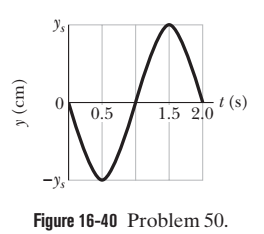
A generator at one end of a very long string creates a wave given by
y=(6.0 \mathrm{cm}) \cos \dfrac{\pi}{2}\left[\left(2.00 \mathrm{m}^{-1}\right) x+\left(8.00 \mathrm{s}^{-1}\right) t\right]
and a generator at the other end creates the wave
y=(6.0 \mathrm{cm}) \cos \dfrac{\pi}{2}\left[\left(2.00 \mathrm{m}^{-1}\right) x-\left(8.00 \mathrm{s}^{-1}\right) t\right]
For x \geq 0, what is the location of the node having the second smallest value of x?
The equation of a transverse wave traveling along a string is
y=0.15 \sin (0.79 x-13 t)
in which x and y are in meters and t is in seconds. what is y_{m}
For a particular transverse standing wave on a long string, one of the antinodes is at x=0 and an adjacent node is at x=0.10 \mathrm{m} . The displacement y(t) of the string particle at x=0 is shown in Fig. 16-40 where the scale of the y axis is set by y_{s}=4.0 \mathrm{cm} . When t=0.50 \mathrm{s}, what is the displacement of the string particle at x=0.30 \mathrm{m} ?
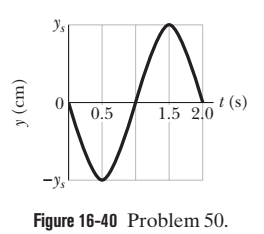
A sinusoidal transverse wave traveling in the positive direction of an x axis has an amplitude of 2.0 \mathrm{cm}, a wavelength of 10 \mathrm{cm}, and a frequency of 400 \mathrm{Hz} . If the wave equation is of the form y(x, t)=y_{m} \sin (k x \pm \omega t), what is the correct choice of sign in front of \omega ?
A sinusoidal transverse wave traveling in the positive direction of an x axis has an amplitude of 2.0 \mathrm{cm}, a wavelength of 10 \mathrm{cm}, and a frequency of 400 \mathrm{Hz} . If the wave equation is of the form y(x, t)=y_{m} \sin (k x \pm \omega t), what is y_{m}
A generator at one end of a very long string creates a wave given by
y=(6.0 \mathrm{cm}) \cos \dfrac{\pi}{2}\left[\left(2.00 \mathrm{m}^{-1}\right) x+\left(8.00 \mathrm{s}^{-1}\right) t\right]
and a generator at the other end creates the wave
y=(6.0 \mathrm{cm}) \cos \dfrac{\pi}{2}\left[\left(2.00 \mathrm{m}^{-1}\right) x-\left(8.00 \mathrm{s}^{-1}\right) t\right]
For x \geq 0, what is the location of the node having the smallest value of x?
Two waves are generated on a String of length 3.0 \mathrm{m} to produce a three-loop standing wave with an amplitude of 1.0 \mathrm{cm} . The wave speed is 100 \mathrm{m} / \mathrm{s} . Let the equation for one of the waves be of the form y(x, t)=y_{m} \sin (k x+\omega t) . In the equation for the other wave, what is y_{m} ?
A single pulse, given by h(x-5.0 t), is shown in Fig. 16-45 for t=0 . The scale of the vertical axis is set by h_{s}=2 . Here x is in centimeters and t is in seconds.Plot h(x-5 t) as a function of t for x=10 \mathrm{cm}

Two sinusoidal& 120Hz waves, of the same frequency and amplitude, are to be sent in the positive direction of an x axis that is directed along a cord under tension. The waves can be sent in phase, or they can be phase-shifted. Figure 16-47 shows the amplitude y^{\prime} of the resulting wave versus the distance of the shift (how far one wave is shifted from the other wave). The scale of the vertical axis is set by y_{s}^{\prime}=6.0 \mathrm{mm} . If the equations for the two waves are of the form y(x, t)=y_{m} \sin (k x \pm \omega t), what is y_{m}
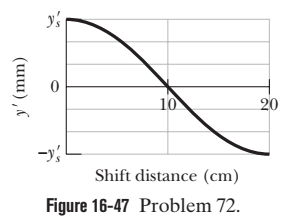
Two sinusoidal& 120Hz waves, of the same frequency and amplitude, are to be sent in the positive direction of an x axis that is directed along a cord under tension. The waves can be sent in phase, or they can be phase-shifted. Figure 16-47 shows the amplitude y^{\prime} of the resulting wave versus the distance of the shift (how far one wave is shifted from the other wave). The scale of the vertical axis is set by y_{s}^{\prime}=6.0 \mathrm{mm} . If the equations for the two waves are of the form y(x, t)=y_{m} \sin (k x \pm \omega t), what is the correct choice of sign in front of \omega ?
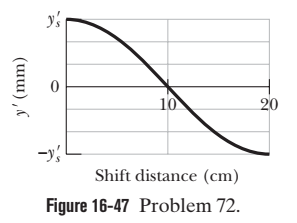
Two sinusoidal waves, identical except for phase, travel in the same direction along a string, producing the net wave y^{\prime}(x, t)=(3.0 \mathrm{mm}) \sin (20 x-4.0 t+0.820 \mathrm{rad}), with x in meters and t in seconds. What are the phase difference between them?
The equation of a transverse wave traveling along a string is
y=(2.0 \mathrm{mm}) \sin \left[\left(20 \mathrm{m}^{-1}\right) x-\left(600 \mathrm{s}^{-1}\right) t\right]
Find the amplitude?
Three sinusoidal waves of the same frequency travel along a string in the positive direction of an x axis. Their amplitudes are y_{1}, y_{1} / 2, and y_{1} / 3, and their phase constants are 0, \pi / 2, and \pi, respectively. What is phase constant of the resultant wave?
Three sinusoidal waves of the same frequency travel along a string in the positive direction of an x axis. Their amplitudes are y_{1}, y_{1} / 2, and y_{1} / 3, and their phase constants are 0, \pi / 2, and \pi, respectively. What is the amplitude ?
Two sinusoidal waves, identical except for phase, travel in the same direction along a string, producing the net wave y^{\prime}(x, t)=(3.0 \mathrm{mm}) \sin (20 x-4.0 t+0.820 \mathrm{rad}), with x in meters and t in seconds. What is their amplitude y_{m} ?
A single pulse, given by h(x-5.0 t), is shown in Fig. 16-45 for t=0 . The scale of the vertical axis is set by h_{s}=2 . Here x is in centimeters and t is in seconds.Plot h(x-5 t) as a function of x for t=2 \mathrm{s}

Figure 16-44 shows the displacement y versus time t of the point on a string at x=0, as a wave passes through that point. The scale of the y axis is set by y_{s}=6.0 \mathrm{mm} . The wave is given by y(x, t)=y_{m} \sin (k x-\omega t+\phi) What is \phi ? (Caution: A calculator does not always give the proper inverse trig function, so check your answer by substituting it and an assumed value of \omega into y(x, t) and then plotting the function.)
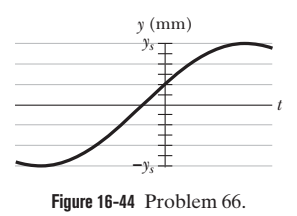
Two waves,
y_{1} =(2.50 \mathrm{mm}) \sin [(25.1 \mathrm{rad} / \mathrm{m}) x-(440 \mathrm{rad} / \mathrm{s}) t]
\text { and } y_{2} =(1.50 \mathrm{mm}) \sin [(25.1 \mathrm{rad} / \mathrm{m}) x+(440 \mathrm{rad} / \mathrm{s}) t]
travel along a stretched string. How can you change the original waves so the resultant wave is the superposition of standing and traveling waves with the same amplitudes as before but with the traveling wave moving in the opposite direction?
A sinusoidal transverse wave traveling in the negative direction of an x axis has an amplitude of 1.00 \mathrm{cm}, a frequency of 550 \mathrm{Hz}, and a speed of 330 \mathrm{m} / \mathrm{s} . If the wave equation is of the form
y(x, t)=y_{m} \sin (k x \pm \omega t), what is y_{m}?
A sinusoidal transverse wave of amplitude y_{m} and wavelength \lambda travels on a stretched cord. Does this ratio depend on the material of which the cord is made?
A standing wave results from the sum of two transverse traveling waves given by
y_{1}=0.050 \cos (\pi x-4 \pi t)
and y_{2}=0.050 \cos (\pi x+4 \pi t)
where x, y_{1}, and y_{2} are in meters and t is in seconds. (a) What is the smallest positive value of x that corresponds to a node? Beginning at t=0?
Two sinusoidal waves of the same wavelength travel in the same direction along a stretched string. For wave 1, y_{m}=3.0 \mathrm{mm} and \phi= 0 ; for wave 2, y_{m}=5.0 \mathrm{mm} and \phi=70^{\circ} . What is the amplitude?
At time t=0 and at position x=0 \mathrm{m} along a string, a traveling sinusoidal wave with an angular frequency of 440 rad/s has displacement y=+4.5 \mathrm{mm} and transverse velocity u=-0.75 \mathrm{m} / \mathrm{s} . If the wave has the general form y(x, t)=y_{m} \sin (k x-\omega t+\phi), what is phase constant \phi ?
A certain transverse sinu-soidal wave of wavelength 20 \mathrm{cm} is moving in the positive direction of an x axis. The transverse velocity of the particle at x=0 as a function of time is shown in Fig. 16-49, where the scale of the vertical axis is set by u_{s}=5.0 \mathrm{cm} / \mathrm{s} . What is the amplitude?
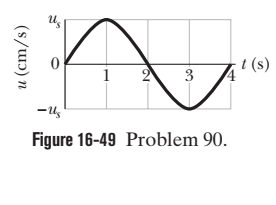
A sinusoidal transverse wave traveling in the negative direction of an x axis has an amplitude of 1.00 \mathrm{cm}, a frequency of 550 \mathrm{Hz}, and a speed of 330 \mathrm{m} / \mathrm{s} . If the wave equation is of the form
y(x, t)=y_{m} \sin (k x \pm \omega t), what is the correct choice of sign in front of \omega ?
Two sinusoidal waves of the same wavelength travel in the same direction along a stretched string. For wave 1, y_{m}=3.0 \mathrm{mm} and \phi= 0 ; for wave 2, y_{m}=5.0 \mathrm{mm} and \phi=70^{\circ} . What is the phase constant of the resultant wave?
Two waves are described by
y_{1}=0.30 \sin [\pi(5 x-200 t)]
and y_{2}=0.30 \sin [\pi(5 x-200 t)+\pi / 3]
where y_{1}, y_{2}, and x are in meters and t is in seconds. When these two waves are combined, a traveling wave is produced. What are the (a)amplitude, (b)wave speed?
Two waves,
y_{1} =(2.50 \mathrm{mm}) \sin [(25.1 \mathrm{rad} / \mathrm{m}) x-(440 \mathrm{rad} / \mathrm{s}) t]
\text { and } y_{2} =(1.50 \mathrm{mm}) \sin [(25.1 \mathrm{rad} / \mathrm{m}) x+(440 \mathrm{rad} / \mathrm{s}) t]
travel along a stretched string.How is the minimum amplitude related to the amplitudes of the original two waves?
Four sound waves are to be sent through the same tube of air, in the same direction:
s_{1}(x, t)=(9.00 \mathrm{nm}) \cos (2 \pi x-700 \pi t)
s_{2}(x, t)=(9.00 \mathrm{nm}) \cos (2 \pi x-700 \pi t+0.7 \pi)
s_{3}(x, t)=(9.00 \mathrm{nm}) \cos (2 \pi x-700 \pi t+\pi)
s_{4}(x, t)=(9.00 \mathrm{nm}) \cos (2 \pi x-700 \pi t+1.7 \pi)
What is the amplitude of the resultant wave? (Hint: Use a phasor diagram to simplify the problem.)
A sound wave of the form s = s_m \cos\left (kx - \omega t + \phi \right ) travels at 343 m/s through air in a long horizontal tube. At one instant, air molecule A at 2.000 m is at its maximum positive displacement of 6.00 nm and air molecule B at x = 2.070 m is at a positive displacement of 2.00 nm. All the molecules between A and B are at intermediate displacements. What is the frequency of the wave?
Two sound waves, from two different sources with the same frequency, 540 Hz, travel in the same direction at 330 \space m/s^{2}. The sources are in phase. What is the phase difference of the wave at a point that is 4.40 m from one source and 4.00 m from the other?
Two waves,
y_{1} =(2.50 \mathrm{mm}) \sin [(25.1 \mathrm{rad} / \mathrm{m}) x-(440 \mathrm{rad} / \mathrm{s}) t]
\text { and } y_{2} =(1.50 \mathrm{mm}) \sin [(25.1 \mathrm{rad} / \mathrm{m}) x+(440 \mathrm{rad} / \mathrm{s}) t]
travel along a stretched string.How is the maximum amplitude related to the amplitudes of the original two waves?
A certain loudspeaker system emits sound isotropically with a frequency of 2000 \mathrm{Hz} and an intensity of 0.960 \mathrm{mW} / \mathrm{m}^{2} at distance of 6.10 \mathrm{m} . Assume that there are no reflections.what are the displacement amplitude ?
In which case is the speed of sound more ; the humming of a bee or the roaring of a lion ?
A sinusoidal sound wave moves at 343 \mathrm{m} / \mathrm{s} through air in the positive direction of an x axis. At one instant during the oscillations, air molecule A is at its maximum displacement in the negative direction of the axis while air molecule B is at its equilibrium position. The separation between those molecules is 15.0 \mathrm{cm}, and the molecules between A and B have intermediate displacements in the negative direction of the axis.
What is the frequency of the sound wave?
Two sound waves with an amplitude of 12 \mathrm{nm} and a wavelength of 35 \mathrm{cm} travel in the same direction through a long tube, with a phase difference of \pi / 3 rad. What is the amplitude of the net sound wave produced by their interference?
Draw displacement-time graph of a wave and show on it the amplitude and time period of wave.
Suppose a spherical loudspeaker emits sound isotropically at 10 \mathrm{W} into a room with completely absorbent walls, floor, and ceiling (an anechoic chamber).
What is the ratio of the wave amplitude at d=4.0 \mathrm{m} to that at d=3.0 \mathrm{m} ?
The wavelength of a wave is 3\ m. If the velocity of the wave is 330\ m/s then find the frequency of that wave. Calculate the time period if the frequency of that wave is reduced to half its value.
Frequency = 110\ Hz.
Time period when frequency is half of its value
110/2 = 55\ Hz
Time Period = 1/n.
In Fig. 35-38, sources A and B emit long-range radio waves of wavelength 400 \mathrm{m}, with the phase of the emission from A ahead of that from source B by 90^{\circ} . The distance r_{A} from A to detector D is greater than the corresponding distance r_{B} by 100 \mathrm{m} . What is the phase difference of the waves at D ?
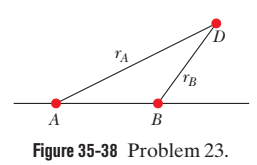
Define following terms in relation to a wave:
(a) amplitude (b) frequency (c) wavelength and (d) wave velocity
What is the angle between the vibration of the particle of medium and the direction of propagation of the wave in a transverse wave?
For the wave described in Exercise 15.8, plot the displacement (y) versus (t) graphs for x=0,2 and 4 \mathrm{cm} . What are the shapes of these graphs? In which aspects does the oscillatory motion In travelling wave differ from one point to another: amplitude, frequency or phase?
Explain following terms
Amplitude of a wave
What do you understand by superposition of waves? Explain.
Write about the reflection of waves.
Write the relation between angular frequency, angular wave number and wave velocity?
For the travelling harmonic wave y(x, t)=2 \cos 2 \pi(10 t-0.0080 x+0.35) where x and y are In centimetre and t In seconds. Calculate the phase difference between oscillatory motion of 2 points separated by a distance of
a) 4 \mathrm{m}
b) 0.5 \mathrm{m}
c) \lambda / 2
d) 3 \lambda / 2
What are waves?
State the principle of superposition. Name the phenomenon produced due to the superposition of waves.
What are elastic waves?
At x s 0.1 m, find the displacement at t = 0.4 sec.
Above figure shows the distance displacement graph. The wave is formed in 2s.
a) What is its amplitude?
b) What is its wavelength?
c) What is its frequency?
d) What is its velocity?
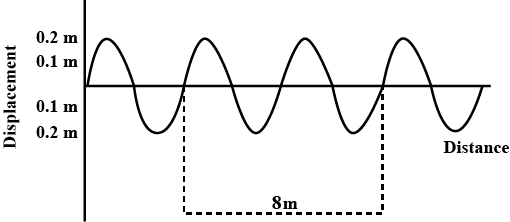
(a) If the coordinate of a particle varies as x= - A \ cos \ \omega t, what is the phase constant in Equation 15.6? (b) At what position is the particle at t=0?
A sinusoidal wave propagating through air has a frequency of 150 Hz. If the wave speed is 200 ms^{-1} how far apart are two points in the medium which have a phase difference of 45^o and 150^o?
A sinusoidal wave propagating through air has frequency of 200 Hz. If the wave speed is 300 m/s, how far apart are two points in the medium with a phase difference of 45^o and 60^o?
Observe the graph given above:
a) What is its amplitude?
b) What is the frequency?
c) Draw the graph of another wave with no change in the frequency and with half of its amplitude.
d) If this wave travels with velocity 300m/s in 1s, calculate the wavelength?
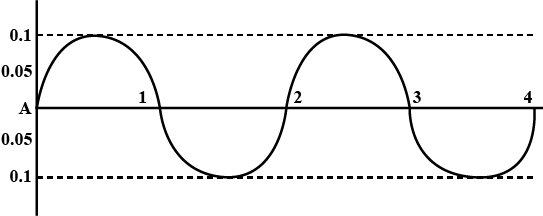
Observe the above graph:
Find out the amplitude of the wave.
What is the speed of the wave if it travels 800 m in 2 s ?
What is the frequency of the wave?

The distance between two particles on a string is 10 cm. Find the phase difference between these particles if the frequency of the wave is 400 Hz and speed is 100 m/s.
At t = 0.1 sec, find the displacement at x = 0.2m
Answer the question:
The diagram show two water waves P and Q that are travelling at the same speed on the surface of a pond. The diagrams are to the same scale.
Which wave has the greater amplitude and which wave has the greater frequency ?
| greater amplitude | greater frequency | |
| A | P | P |
| B | P | Q |
| C | Q | P |
| D | Q | Q |
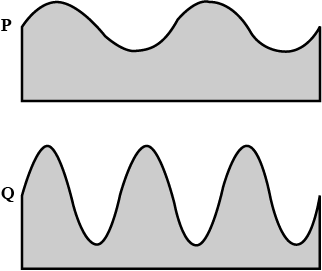
A radio station serves listeners in a city to the northeast of its broadcast site. It broadcasts from three adjacent towers on a mountain ridge, along a line running east to west, in what's called a phased array. Show that by introducing time delays among the signals the individual towers radiate, the station can maximize net intensity in the direction toward the city (and in the opposite direction) and minimize the signal transmitted in other directions.
Rank the waves represented by the following functions from the largest to the smallest according to (i) their amplitudes, (ii) their wavelengths, (iii) their frequencies, (iv) their periods, and (v) their speeds. If the values of a quantity are equal for two waves, show them as having equal rank. For all functions, x and y are in meters and t is in seconds. (a) y = 4 sin (3x - 15t) (b) y = 6 cos (3x + 15t - 2) (c) y = 8 sin (2x + 15t) (d) y = 8 cos (4x + 20t) (e) y = 7 sin (6x - 24t).
Show that the two waves with wave functions given by E_{1} = 6.00 sin (100 \pi t) and E_{2} = 8.00 sin (100 \pi t + \pi/2) add to give a wave with the wave function E_{R} =sin(100 \pi t + \phi). Find the required values for E_{R} and \phi .
When two progressive waves y_{1}=4\sin(2x\ - 6t) and y_{2}=3\sin(2x-6t-\dfrac{\pi}{2}) are superimposed, the amplitude of the resultant wave is
A small pulse travelling with speed v in a string is shown at t = 0, moving towards free end. Select the shape of string from column-II at moments shown in column-I
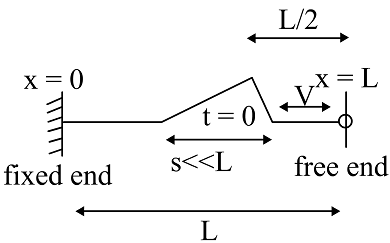
The block shown in the figure, is acted on by a spring with spring constant k and a weak frictional force of constant magnitude f. The block is pulled a distance \displaystyle x_{0} from equilibrium position and then released. It oscillates many times and ultimately comes to rest. Show that the decrease of amplitude is the same for each cycle of oscillation.

The initial position and velocity of a body moving in SHM with period T=0.25\ s are x=5.0\ cm and v=218\ cm/s. What are the amplitude and phase difference of the motion?
The motion of a particle executing simple harmonic motion is described by the displacement function, x(t) = A \cos \left ( \omega t+\phi \right ).
If the initial (t = 0) position of the particle is 1 cm and its initial velocity is \omega cm/s, what are its amplitude and initial phase angle ? The angular frequency of the particle is \pi s^{-1}. If instead of the cosine function we choose the sine function to describe the SHM : x = B\sin (\omega t + \alpha ), what are the amplitude and initial phase of the particle with the above initial conditions.
A source S and a detector D are placed at a distance d apart. A big cardboard is placed at a distance \sqrt{2}d from the source and the detector as shown in figure. The source emits a wave of wavelength = d/2 which is received by the detector after reflection from the cardboard. It is found to be in phase with the direct wave received from the source. By what minimum distance should the cardboard be shifted away so that the reflected wave becomes out of phase with the direct wave?
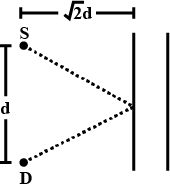
Two coherent transverse waves of amplitude 2A and A of same frequency propagated respectively along +ve and -ve x-axis are superimposed. The amplitude of the wave at a distance of 5 cm from the origin, (given \ K = \dfrac{\pi}{4}cm^{-1}) is:
When a transverse plane wave traverses a medium, individual particles execute periodic motion given by the equation y = 0.25 cos(2\pi t-\pi x). The phase difference for two position of same particle which are occupied by time intervals 0.4 second apart is
A wave of frequency 500 Hz has a velocity { 360ms }^{ -1 } the phase difference between two displacement t a certain point at time { 10 }^{ -3 } s apard will be
Two waves, each having a frequency of 100 { Hz } and a wavelength of 2.0 { cm }, are travelling in the same direction on a string. What is the phase difference between the waves ( a ) if the second wave was produced 0.015 s later than the first one at the same place, (b) if the two waves were produced at a same instant but the first one was produced a distance 4.0 { cm }, behind the second one ? (c) If each of the waves has an amplitude of 2.0 { mm }, what would be the amplitudes of the resultant waves in part (a) and (b) ?
Explain ground wave propagation.
Two particles describe S.H.M of the same period and same amplitude along the same line about the same equilibrium position O. At a moment when they are at the same displacements their velocities are 1.6\ m/s in opposite directions. At another moment when their displacement are equal in magnitude but on either side of O their velocities are 1.2\ m/s in the same direction. Find the maximum speed of the particles and the phase difference between them.
In the arrangement shown in fig. a mass can be hung from a string ( with a linear mass density of \mu =0.00200\ kg/m) that passes over a light pulley. The string is connected to a vibrator ( of constant frequency f ), and the length of the string between point P and the pulley is L=2.00\ m. When the mass m is either 16.0\ kg or 25.0\ kg, standing waves are observed; however, no standing waves are observed with any mass between these values.
What is the frequency of the vibrator ?
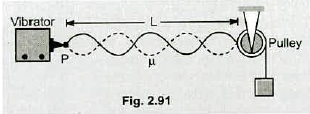
Suppose two linear waves of equal amplitude and frequency have a phase difference \phi as they travel in the same medium. They can be represented by
y_1 =A \sin (kx -\omega t)
y_2 =A \sin (kx -\omega t + \phi)
What is the amplitude of this resultant wave? Is the wave purely sinusoidal, or not ?
The two sources shown in figure 2.25 emit sound waves, in phase, each of wavelength \lambda and amplitude A. Consider a point such as C in the diagram and let r_A and r_B be the distance of this point from source A and source B, respectively. Show that if r_A and R_B are nearly equal, (r_A -r_B << r_A), then the amplitude varies approximately with position as
\left(\dfrac {2A}{r_A}\right) \cos \dfrac {\pi}{\lambda}(r_A -r_B)
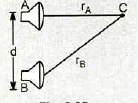
A 100 \,Hz sinusodial wave is travelling in the positive x-direction along a string with a linear mass density of 3.5 \times 10^{-3} \,kg/m and a tension of 35 \,N. At time t = 0, the point x = 0 has maximum displacement in the positive y-direction. Next, when this point has zero displacement the slope of the string is \pi / 20. Find (i) amplitude (ii) wave speed (iii) the expression which represents the displacement of string as a function of x (in metres) and t (in seconds).
Figure 16-46 shows transverse acceleration a_{y} versus time t of the point on a string at x=0, as a wave in the form of y(x, t)=y_{m} \sin (k x-\omega t+\phi) passes through that point. The scale of the vertical axis is set by a_{s}=400 \mathrm{m} / \mathrm{s}^{2} . What is \phi ? (Caution: A calculator does not always give the proper inverse trig function, so check your answer by substituting it and an assumed value of \omega into y(x, t) and then plotting the function.)
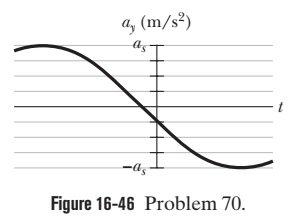
Two sinusoidal waves with the same amplitude of 9.00 \mathrm{mm} and the same wavelength travel together along a string that is stretched along an x axis. Their resultant wave is shown twice in Fig. 16-38, as valley A travels in the negative direction of the x axis by distance d=56.0 \mathrm{cm} in 8.0 \mathrm{ms} . The tick marks along the axis are separated by 10 \mathrm{cm}, and height H is 8.0 \mathrm{mm} . Let the equation for one wave be of the form y(x, t)=y_{m} \sin \left(k x \pm \omega t+\phi_{1}\right), where \phi_{1}=0 and you must choose the correct sign in front of \omega . For the equation for the other wave, what is \phi_{2}
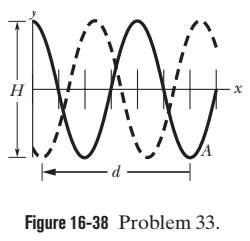
Two sinusoidal waves with the same amplitude and wavelength travel through each other along a string that is stretched along an x axis. Their resultant wave is shown twice in Fig. 16-41 , as the antinode A travels from an extreme upward displacement to an extreme downward displacement in 6.0 ms. The tick marks along the axis are separated by 10 \mathrm{cm} ; height H is 1.80 \mathrm{cm} . Let the equation for one of the two waves be of the form y(x, t)=y_{m} \sin (k x+\omega t) . In the equation for the other wave, what is the sign in front of \omega ?

Figure 16-32 shows the transverse velocity u versus time t of the point on a string at x = 0, as a wave passes through it. The scale on the vertical axis is set by u_s = 4.0 \space m/s. The wave has the generic form y\left (x, t \right ) = y_m \sin \left (kx - \omega t + \phi \right ). What then is \phi? (caution : A calculator does not always give the proper inverse trig function, so check your answer by substituting it and an assumed value of \omega into y\left (x, t \right ) and then plotting the function.)
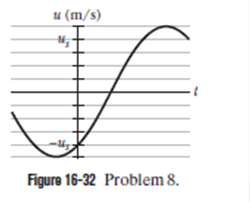
A continuous sinusoidal longitudinal wave is sent along a very long coiled spring from an attached oscillating source. The wave travels in the negative direction of an x axis; the source frequency is 25 \mathrm{Hz} ; at any instant the distance between successive points of maximum expansion in the spring is 24 \mathrm{cm} ; the maximum longitudinal displacement of a spring particle is 0.30 \mathrm{cm} ; and the particle at x=0 has zero displacement at time t=0 . If the wave is written in the form s(x, t)=s_{m} \cos (k x \pm \omega t), what is s_{m}?
Two sinusoidal waves with the same amplitude and wavelength travel through each other along a string that is stretched along an x axis. Their resultant wave is shown twice in Fig. 16-41 , as the antinode A travels from an extreme upward displacement to an extreme downward displacement in 6.0 ms. The tick marks along the axis are separated by 10 \mathrm{cm} ; height H is 1.80 \mathrm{cm} . Let the equation for one of the two waves be of the form y(x, t)=y_{m} \sin (k x+\omega t) . In the equation for the other wave, what is y_{m}
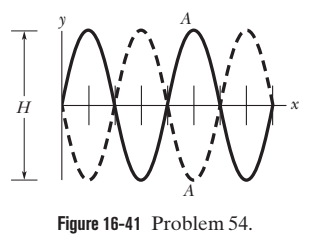
A transverse sinusoidal wave is moving along a string in the positive direction of an x axis with a speed of 80 m/s. At t = 0, the string particle at x = 0 has a transverse displacement of 4.0 cm from its equilibrium position and is not moving. The maximum transverse speed of the string particle at x = 0 is 16 m/s. (a) What is the frequency of the wave? (b) What is the wavelength of the wave? If \left (x, t \right ) = y_m \sin \left (kx \pm \omega t + \phi \right ) is the form of the wave equation, what are (c) y_m, (d) k, (e) \omega (f) \phi, and (g) the correct choice of sign in front of \omega ?
Two sinusoidal waves with the same amplitude of 9.00 \mathrm{mm} and the same wavelength travel together along a string that is stretched along an x axis. Their resultant wave is shown twice in Fig. 16-38, as valley A travels in the negative direction of the x axis by distance d=56.0 \mathrm{cm} in 8.0 \mathrm{ms} . The tick marks along the axis are separated by 10 \mathrm{cm}, and height H is 8.0 \mathrm{mm} . Let the equation for one wave be of the form y(x, t)=y_{m} \sin \left(k x \pm \omega t+\phi_{1}\right), where \phi_{1}=0 and you must choose the correct sign in front of \omega . For the equation for the other wave, what is y_{m}?
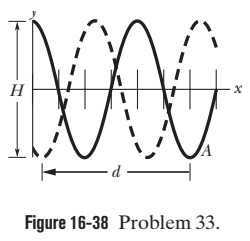
Two sinusoidal waves with the same amplitude of 9.00 \mathrm{mm} and the same wavelength travel together along a string that is stretched along an x axis. Their resultant wave is shown twice in Fig. 16-38, as valley A travels in the negative direction of the x axis by distance d=56.0 \mathrm{cm} in 8.0 \mathrm{ms} . The tick marks along the axis are separated by 10 \mathrm{cm}, and height H is 8.0 \mathrm{mm} . Let the equation for one wave be of the form y(x, t)=y_{m} \sin \left(k x \pm \omega t+\phi_{1}\right), where \phi_{1}=0 and you must choose the correct sign in front of \omega . For the equation for the other wave, what is the sign in front of \omega ?
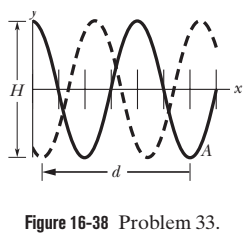
A continuous sinusoidal longitudinal wave is sent along a very long coiled spring from an attached oscillating source. The wave travels in the negative direction of an x axis; the source frequency is 25 \mathrm{Hz} ; at any instant the distance between successive points of maximum expansion in the spring is 24 \mathrm{cm} ; the maximum longitudinal displacement of a spring particle is 0.30 \mathrm{cm} ; and the particle at x=0 has zero displacement at time t=0 . If the wave is written in the form s(x, t)=s_{m} \cos (k x \pm \omega t), what is the correct choice of sign in front of \omega ?
At a certain point, two waves produce pressure variations given by \Delta p_{1}=\Delta p_{m} \sin \omega t and \Delta p_{2}=\Delta p_{m} \sin (\omega t-\phi) . At this point, what is the ratio \Delta p_{r} / \Delta p_{m}, where \Delta p_{r} is the pressure amplitude of the resultant wave, if \phi \text{ is } \pi / 2
A plane elastic wave \xi =ae^{\gamma x}\cos(\omega t-kx) where a,\gamma,\omega, and k are constants, propagates in a homogeneous medium. Find the phase difference between the oscillation at the points where the particle' displacement amplitudes differ by \eta=1.0\%, if \gamma=0.42\ m^{-1} and the wavelength is \lambda=50\ cm.
The equation of a wave propagating on a string is as follows :
y = 10 sin \pi(0.01 x - 2.00t) where y and x are in cm and t is in second. Calculate the amplitude, frequency and velocity of the wave. Calculate the phase difference between the two particles at a distance 40.0 cm at any instant.
At a certain point, two waves produce pressure variations given by \Delta p_{1}=\Delta p_{m} \sin \omega t and \Delta p_{2}=\Delta p_{m} \sin (\omega t-\phi) . At this point, what is the ratio \Delta p_{r} / \Delta p_{m}, where \Delta p_{r} is the pressure amplitude of the resultant wave, if \phi \text{ is } \pi / 3
A sound wave generated in 4 seconds is shown in the above graph. If wavelength of the wave is 15m, calculate:
a) Frequency of the wave.
b) Distance traveled by the wave in 4 seconds.
c) Find out the amplitude of the wave.

A transverse sinusoidal wave on a string has a period T = 25.0\ ms and travels in the negative x direction with a speed of 30.0\ m/s. At t = 0, an element of the string at x = 0 has a transverse position of 2.00\ cm and is traveling downward with a speed of 2.00\ m/s. (a) What is the amplitude of the wave? (b) What is the initial phase angle? (c) What is the maximum transverse speed of an element of the string? (d) Write the wave function for the wave.
Class 11 Engineering Physics Extra Questions
- Gravitation Extra Questions
- Kinetic Theory Extra Questions
- Laws Of Motion Extra Questions
- Mechanical Properties Of Fluids Extra Questions
- Mechanical Properties Of Solids Extra Questions
- Motion In A Plane Extra Questions
- Motion In A Straight Line Extra Questions
- Oscillations Extra Questions
- Physical World Extra Questions
- Systems Of Particles And Rotational Motion Extra Questions
- Thermal Properties Of Matter Extra Questions
- Units And Measurement Extra Questions
- Waves Extra Questions
- Work,Energy And Power Extra Questions
